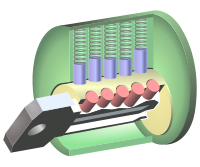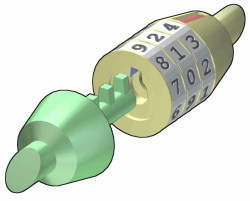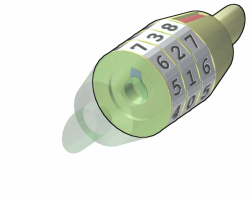Lockpicking
We tried different practice locks in order to learn lock picking.
Pin tumbler lock (Stiftschloss)

Without a key in the lock, the driver pins (blue) are pushed downwards, preventing the plug (yellow) from rotating.

When an incorrect key is inserted into the lock, the key pins (red) and driver pins (blue) do not align with the shear line; therefore, it does not allow the plug (yellow) to rotate.

When the correct key is inserted, the gaps between the key pins (red) and driver pins (blue) align with the edge of the plug (yellow).

With the gaps between the pins aligned with the shear line, the plug (yellow) can rotate freely.
Combination lock (Zahlenschloss)

Exploded view of the rotating discs. The notches on the disc correspond to the numerals in the correct combination. In this case, the combination is 9-2-4.

The discs are mounted on one side of the lock, which may in turn be attached to the end of a chain or cable. The other side of the lock, or the other end of the cable, has a pin with several protruding teeth.

When the toothed pin is inserted and the discs are rotated to an incorrect combination, the inner faces of the discs block the pin from being extracted.
Bumperkeys (Schlagschlüssel)
https://en.wikipedia.org/wiki/Lock_bumping